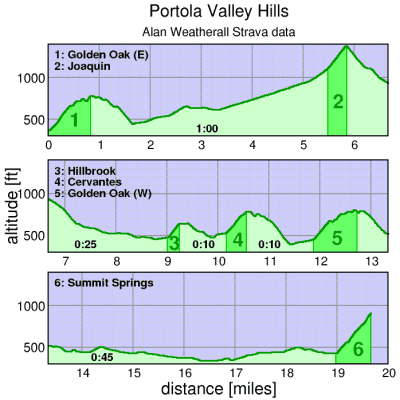Low-Key Hillclimbs: 2013 challenges and Portola Valley Hills

I spent a lot of time recently working on the web pages for the 2013 Low-Key Hillclimbs. Every year this series takes an enormous amount of time and every year I wonder if I want to scale it back or maybe even not do it again but the enthusiasm of participants always keeps me going, and every year I tweak things a bit to keep it fresh. For example, in 2012 I blew out my previous constraints on scoring code complexity, but the result was a much fairer balancing of scores week-to-week. Additionally 2012 was the first year using GPS timing, which worked extremely well for week 7 up Montara Mountain.
This year brought two big changes: "coordinator's choice" where coordinators could pick their own climbs (rather than attempting to pick a balanced selection myself). This yielded an excellent schedule. But the big one is week 4: Portola Valley Hills, a GPS timing week much more complex than last year's dirt climb.
The way of thinking about how the timing is working on this week is to think of a series of checkpoints defined by timing gates. The timing gates extend from left to right, substantially beyond the width of the road to accomodate GPS position error. The riders must cross the timing gates in the correct direction and in sequence. Crossing a gate in the wrong direction is ignored. If a rider re-crosses an earlier gate, the rider must continue the course from that point. If the rider completes the entire course multiple times, the fastest time is retained.
I do two things with these "gates": (1) timing for the full course, (2) split times along the course.
For timing, I have certain checkpoints (gates) as mandatory, others optional. All of the checkpoints in Portola Valley Hills are mandatory. If any are skipped or otherwise not crossed properly, the course is considered to be not completed. The route between checkpoints isn't checked, so I need to make sure I have enough checkpoints that the shortest and quickest route between them is the official course.
Adjacent pairs of mandatory checkpoints define course segments. Course segments may have an optional time budget. If the segment is traveled in less than or equal to the time budget, that segment doesn't contribute to the total time. If more than the time budget is taken, then the time budget is subtracted from the time taken for contribution to the total time.
For Portola Valley Hills, I use time budgets to allow riders ample time to get from the top of one hill to the base of the next. I don't want them to feel rushed here, but I want the ride to be essentially continuous. I don't want riders stretching the day out to optimize recovery between timed climbs: that would be unfair to those with reasonable time constraints.
The other role of checkpoints is for split timings. Split times are defined as a pair of checkpoints. Split times are the one application of optional checkpoints: if the rider, due to GPS error for example, doesn't cross an optional checkpoint then he isn't ranked for splits including that checkpoint but he's still considered for overall time for the course.
Placing checkpoints is a bit of an art. You want them where there's little ambiguity about the rider's trajectory. For example, you wouldn't want one at the apex of a switchback: GPS errors would wreak havoc with that. Better in a long, straight section of road well separate from other portions of the road.

One challenging aspect of the route is navigation. The route includes a lot of turns, a lot of opportunity for error. In many cases, particularly Peak Road and adjacent Golden Oak, the road is traveled multiple times in the same or opposite direction. I recommend riders download a course from the Garmin Connect entry I've prepared. But Garmin Edge navigation can have problems with these re-entrant routes. It tries to allow for the scenario where a rider's GPS is turned on during the ride, so doesn't assume the ride began at the route start. I'm worried it will give incorrect directions in this case.
I may need to take extreme measured, like prepare an old-school paper route sheet, or arrange for the course to be marked with chalk. But the best thing is for riders to memorize the hill sequence, then ride in groups to avoid individual errors. There's plenty of time for riders of similar speed to regroup immediately after climbs and for the first to the top to still get to the base of the next climb within the time budget.
Hopefully this goes well. I'm sure there will be some snafus, but the orienteering challenge is just part of the fun.

Comments